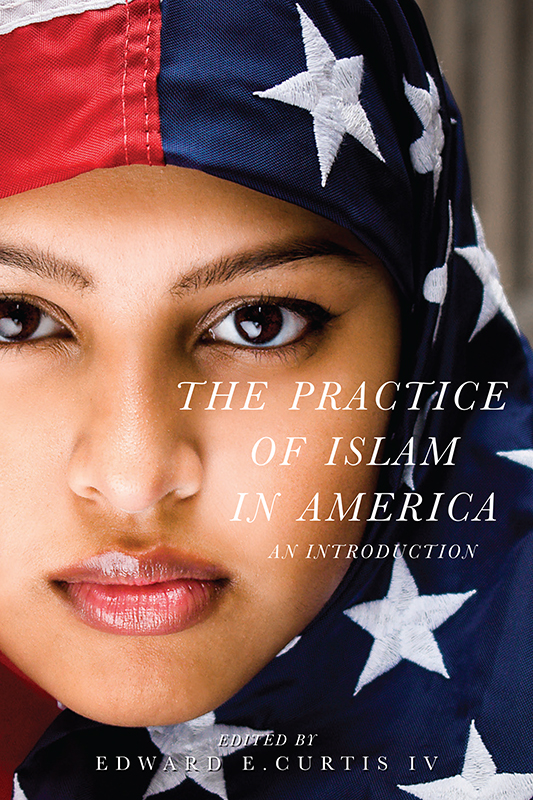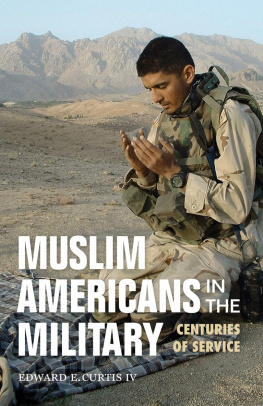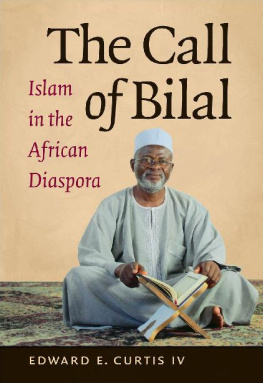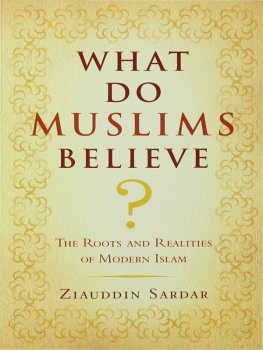
The Practice of Islam in America
The Practice of Islam in America
An Introduction
Edited by Edward E. Curtis IV

NEW YORK UNIVERSITY PRESS
New York
NEW YORK UNIVERSITY PRESS
New York
www.nyupress.org
2017 by New York University
All rights reserved
References to Internet websites (URLs) were accurate at the time of writing. Neither the author nor New York University Press is responsible for URLs that may have expired or changed since the manuscript was prepared.
Library of Congress Cataloging-in-Publication Data
Names: Curtis, Edward E., 1970 editor.
Title: The practice of Islam in America : an introduction / edited by Edward E. Curtis IV.
Description: New York : New York University Press, [2017] | Includes bibliographical references and index.
Identifiers: LCCN 2017008038| ISBN 9781479882670 (cl : alk. paper) | ISBN 9781479804887 (pb : alk. paper)
Subjects: LCSH : MuslimsUnited States. | IslamCustoms and practices. | Religious lifeIslam.
Classification: LCC BP67.U6 P73 2017 | DDC 297.0973dc23
LC record available at https://lccn.loc.gov/2017008038
New York University Press books are printed on acid-free paper, and their binding materials are chosen for strength and durability. We strive to use environmentally responsible suppliers and materials to the greatest extent possible in publishing our books.
Manufactured in the United States of America
10 9 8 7 6 5 4 3 2 1
Also available as an ebook
To Vernon Schubel and Ahmet Karamustafa
Contents
Edward E. Curtis IV
Rose Aslan
Rosemary R. Corbett
Hussein Rashid
Jackleen Salem
Michael Muhammad Knight
Marcia Hermansen
Maria F. Curtis
Juliane Hammer
Amir Hussain
Danielle Widmann Abraham
Magfirah Dahlan
Muna Ali
It is my pleasure, first, to acknowledge the volumes twelve contributors. They put up with my devotion to deadlines and, more importantly, rendered a rich and vibrant portrait of Islamic religious life in the United States.
In July 2016, many of us came together on the campus of Indiana University-Purdue University Indianapolis (IUPUI) to critique one anothers drafts and offer constructive suggestions for improvement. This meeting improved the quality of the volume and gave us a rare opportunity to share ideas in a collegial, supportive setting.
As part of our meetings, we held a dinner in which Muslim community members from every part of the greater Indianapolis metropolitan area came together to hear about our progress and provide feedback. My community partners were essential to pulling this off. Gratitude goes to Rima Khan Shahid of the Muslim Alliance of Indiana, Imam Michael Saahir of Nur Allah Islamic Center, Imam Ismail Abdul-Aleem of Masjid al-Mumineen, Vice President Muhammad Safder of the Muslim Community Center, Sr. Habibe Ali of the Islamic Society of North America, and Dr. Sohel Anwar of al-Huda Foundation. We were also honored by the presence of retired Judge David Shaheed and City Controller Fady Qaddoura.
Lauren Schmidt of IUPUIs Center for the Study of Religion and American Culture coordinated both the authors meeting and the community dinner, and it couldnt have been better organized or implemented. Nate Wynne also offered essential assistance. My thanks go to both of them.
Financial support for these events was provided by Indiana Universitys New Frontiers in the Arts and Humanities Program and by a collaborative research grant from the American Academy of Religion. I thank Dr. Faith Kirkham Hawkins, IUs associate vice president for research, for helping me navigate the grant application and its implementation. None of these parties is responsible for the content of this book.
My academic home, the IU School of Liberal Arts, provided a supportive environment for planning the volume, recruiting the contributors, editing the first drafts, and then finishing the manuscript.
For years, NYU Press senior editor Jennifer Hammer and I have been looking to collaborate on a project, and I am grateful that I had the chance to work with such a consummate professional. Also at the press, Amy Klopfenstein and Dorothea Stillman Halliday were very helpful indeed. Usha Sanyal copyedited the manuscript, and Jeremy Rehwaldt, Ph.D., proofread the galleys.
I conceptualized this volume as a book that could be used by college teachers to introduce their students to Islamic religious practice. And so, it is appropriate that I have dedicated the volume to two of my own Islamic studies teachers: Vernon Schubel, professor at Kenyon College, and Ahmet Karamustafa, now professor at the University of Maryland. Vernon and Ahmet are everything that anyone could want in a teacherinspiring, brilliant, helpful, and encouraging. I remain so deeply grateful to them.
Edward E. Curtis IV
Muslims were practicing Islam on American soil long before the United States declared its independence in 1776. Perhaps the most famous Muslim to set foot in the British North American colonies was Ayuba Suleiman Diallo (17011773), better known in U.S. history as Job ben Solomon. Very constant in his devotions, according to his biographer Thomas Bluett, Diallo was a highly educated religious leader who was a member of the ruling family of Futa Toro in Senegambia, West Africa. Enslaved in 1730 and brought to Annapolis, Maryland, he was sold to a settler who lived on Kent Island in Chesapeake Bay, where he lived until 1733. At first made to work as a hand in the tobacco fields, Ayuba, or Job, eventually became a cattle herder. Job would often leave the cattle, according to Bluett, and withdraw into the woods to pray. As a trained imam, or prayer leader, Ayuba would likely try his best to point his body toward Mecca, Arabia, just as other Muslims do when they prostrate their bodies in the direction of Islams most important shrine. But a white boy frequently watched him, recounted Bluett, and whilst he was at his devotion would mock him, and throw dirt in his face.
Bluett said this harassment very much disturbed Job, but it did not prevent him from continuing his religious practice. Bluett first discovered that Ayuba was a Muslim when Ayuba pronounced the words Allah and Mahommed; by which, and his refusing a glass of wine we offered him, we perceived he was a Mahometan [Muslim]. Even though he could not speak English, Ayuba believed, correctly, that invoking the names of Allah, the Arabic word for God, and the Prophet Muhammad, whom Muslims revere as the Messenger of God, would successfully communicate his identity as a Muslim. Bluett was impressed by the sincere reverence that seemed to accompany Ayubas every mention of Gods name: he showed upon all occasions a singular veneration for the For him, God was One, not Three in One.
Ayuba Suleiman Diallo was one of tens of thousands of Muslim Americans who were performing Islamic rituals and following ethical norms outlined in the Sharia before the United States became an independent nation in 1776. Today approximately 1 to 2 percent of the U.S. population is Muslim, meaning that there are perhaps 3 to 6 million Muslims in the United States.
This book is driven by the desire to provide clear answers to essential, but basic, questions about how observant Muslim Americans practice Islam: How do they pray? What religious holidays do they celebrate? How do Muslim Americans welcome a child into the world, get married, and bury their dead? What dietary rules do they follow? What kinds of charitable activities do they do? What is it like for American Muslims to go on
Next page







